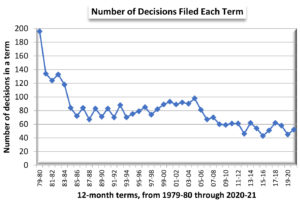With the arrival of spring, it’s time for SCOWstat’s annual estimate of the number of decisions that the court will have filed once the books close in late July. Information now in hand should allow us to predict the actual total almost exactly.
Through May 16 the justices had already decided 24 cases and conducted oral argument in 29 more.[1] Past practice indicates strongly that all of these 29 pending cases will receive decisions by the end of July, yielding a sum of 53 cases.[2] This leaves only John Doe 1 v. Madison Metro School District in doubt. Here, a late oral argument has been scheduled for May 24, making it hard to foresee whether the justices will have enough time to file a decision before the term expires. All the other pending cases have yet to reach oral argument and will have to await resolution next term.
Thus, we can expect 53 or 54 decisions in 2021-22—nearly the same as the total of 52 for the previous term, as shown in the following graph.[3]
The graph provides a general impression of the long-term trend, but we can also summarize the information by calculating the average number of decisions filed per term for each of the past four decades.
Decade 1 (1981-82 through 1990-91): 92 cases per term.
Decade 2 (1991-92 through 2000-01): 81 cases per term
Decade 3 (2001-02 through 2010-11): 77 cases per term
Decade 4 (2011-12 through 2020-21): 53 cases per term
The most precipitous decline occurred from decade 3 to decade 4, when the average fell to 53 cases per term. This matches our estimate for 2021-22—and suggests that an output in the low-to-mid 50s is becoming the new normal.
[1] The following cases are past oral argument and awaiting decisions:
Colectivo Coffee Roasters, Inc. v. Society Insurance
Container Life Cycle Management, LLC v. DNR
County of Dane v. Public Service Commission of Wisconsin
Daniel Doubek v. Joshua Kaul
Friends of Frame Park, U.A. v. City of Waukesha
Friends of the Black River Forest v. DNR
Great Lakes Excavating, Inc. v. Dollar Tree Stores, Inc.
Gregory M. Backus v. Waukesha County
James Cobb v. Gary A. King
Joshua L. Kaul v. Frederick Prehn
Richard Teigen v. Wisconsin Elections Commission
Sauk County v. S. A. M.
Sheboygan County v. M.W.
State v. Alan S. Johnson
State v. Avan Rondell Nimmer
State v. C. G.
State v. Chrystul D. Kizer
State v. Donald P. Coughlin
State v. Nhia Lee
State v. Richard Michael Arrington
State v. Robert Daris Spencer
State v. Ryan Hugh Mulhern
State v. Scott W. Forrett
State v. Theophilous Ruffin
State v. Valiant M. Green
State v. Westley D. Whitaker
State v. X.S.
Wisconsin Manufacturers and Commerce v. Tony Evers
Wisconsin Property Tax Consultants, Inc. v. Wisconsin Department of Revenue
[2] I am counting Billie Johnson v. Wisconsin Elections Commission three times because it resulted in three substantial decisions (filed November 30, 2021, March 3, 2022, and April 15, 2022). Timothy Rave v. SVA Healthcare Services, LLC is excluded because the petition for review was ultimately dismissed on grounds of mootness.
[3] The graph’s total of 52 cases for 2020-21 includes a deadlocked (3-3) per curiam decision in Portage County v. E. R. R. Although I normally omit 3-3 decisions from SCOWstats calculations, they have figured in the numbers for earlier years in this graph, so I will continue to include them in these updates. They are rare—with none so far in 2021-22.

Speak Your Mind